Pro Football Jigs with Weedguards
Football jigs have always been most popular in the western USA, and to a lesser degree, in isolated pockets in the north central and southeast regions mainly.
Within recent years, however, on the top pro tours, a shift has been made to deeper baits and deeper spots fished by top pros in prestigious televised tournaments. Top pros are increasingly learning to probe deeper offshore spots for untapped bass. The pros are discovering new lures to them (like football jigs) will win deep tournaments country-wide. Consequently, the football jig has grown in popularity among local tournament and recreational anglers who pick up new techniques and tactics (like football jig fishing) from the pros on TV and in magazine articles.
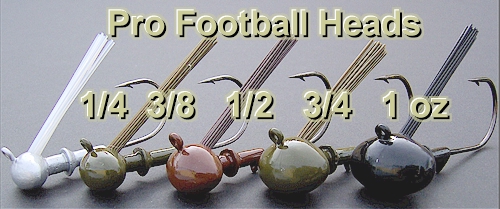
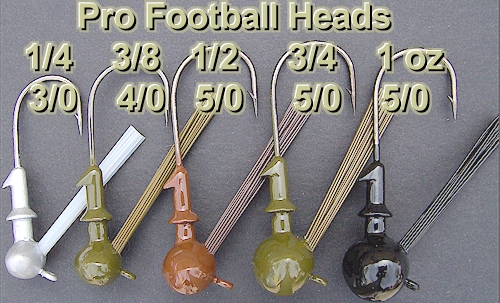
L to R: Silver, Green Pumpkin, Brown, Green Pumpkin, Black.
Cast Industries manufactures, centrifugal spincast molds and paints these jig heads. Cast Industries is the largest U.S. manufacturer of jig heads for over 20 years with over 300 customers, including many of the most popular brands of jigs on tackle store shelves worldwide. Quite simply, Cast Industries produces many of the best made jigs on the market.

These have a premium Mustad UltraPoint round bend hook model.
You'll appreciate the consistent hooking experience provided by a jig with the standard round bend hook in it (as opposed to other angled or irregular jig hook bends). This wide gap, round bend forged Mustad hook consistently hooks and holds fish better.
Recommended Gear: These jigs are best used with medium to medium/heavy gear from 10 to 16 pound test mono, fluoro or braided line. The hook is stout, but it is not intended for heavy flipping gear or heavy braided line.
Rigging Method: Start by optionally dressing a football jig with or without a silicone skirt (shown below). In any case (with or without a skirt), always add a soft plastic bait of your choice (not shown).
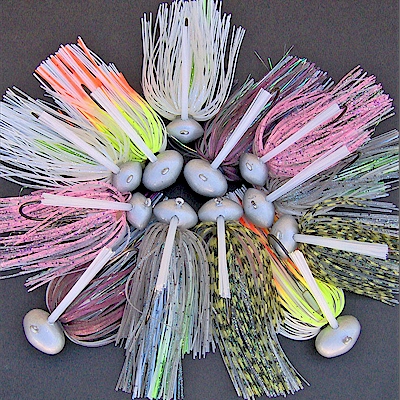
Football Jig pile-up! 1/2, 3/4 and 1 ounce sizes. Same 5/0 hook in all.
Differences Between Football Jigs and Other Jig Shapes
More streamlined jig heads (most all other jig head shapes) will snag more on rocky bottom types than will the football jig. Even if a football jig does get lodged in a snag, it will not lodge as deeply, and can be unsnagged more easily than other jigs, especially if you are able to backpedal to get right over the snagged jig in order to get it out the same way or same angle that it went in.
Many other jig heads will roll on their sides, putting the hook right on the bottom. Due to its oblong sideways head however, a football jig really cannot roll over. A football jig tends to keep the hook straight up most of the time, and it is hard to envision the hook snagging when it's upright. A hook tends to snag when it's rolled into the bottom or when the hook's rolled into a limb - but the football head tends not to roll over as much as other jigs.
Use of Standard Weight Sizes
The 1/4, 3/8 and 1/2 ounce sizes are great to use in rock bottom areas because the oblong head shape helps keep the jig head perched atop bottom rubble without slipping and sliding down deep into small cracks and openings amidst the debris.
When Heavy Football Jigs Really Come Into Their Own
Where football heads really come into their own, however, is with the heavy 3/4 and 1 ounce sizes. The heavy heads really define what football jig fishing is. The heavyweight heads separate football jigging from all other types of jig tactics. The 3/4 and 1 ounce jigs have a big presence, they displace a lot of water and create a disturbance that doesn't go unnoticed by deep bass. They sink fast. They hit the bottom and hit any underwater obstacles hard, causing a fast-snapping reaction bite at times. Think of an apple tree. If a light leaf fell off the top of the apple tree and fluttered silently to the ground, you would hardly pay attention. You might not even notice at all. If a ponderous apple fell off the tree top and smashed the ground hard, you are very likely to turn your head to see what just happened there. That's why a heavy football jig works so well. It gets attention plummeting down and thudding the bottom hard, and when fish turn their heads to see what's happening, your football jig is on the scene, appearing edible or alive.
Is the Football Jig a Crawdad Imitation?
Many anglers pigeonhole the football jig as a crawdad imitation. Yet the football jig isn't exactly a true copy of a crawdad - or anything else. A bass may not know what a football jig represents, except that as the football bangs the bottom and crashes head-on into bottom debris - even when it just lays there immobile - it appears like something that is not a perfect, healthy specimen, therefore an easier meal to catch than a perfectly healthy craw or minnow.
So the football jig imitates nothing in particular and everything in general. Depending on the color of the jig head, the color and kind of dressing you apply (you may dress it with a silicone skirt plus any kind of soft plastic or pork trailer - or just use soft baits like hula grubs, creatures, beavers or craws alone without skirts) and depending on the action that an angler uses, a football can give fish the impression of a craw, a panfish, a shad, a young-of-year walleye, trout, etc. So when you know that bass are feeding heavily on one particular kind of food source, it can help to try to match the hatch. For example, when bass are feeding heavily on shad, it can help to use a silver jig head, with a silvery white dressing (skirt and/or soft bait). Yet above all, a football jig is just something non-descript and moving - an easy target that bass strike.
Hold Down the Head-Shaking or Else!
In deep water, bass are notorious for racing to the top to leap out of the water as soon as they are hooked, often dislodging a heavy football jig when they jump. This is often unavoidable. It is almost impossible to reel in slack line as quickly as a fish can rocket straight to the top. Even if you do reel fast enough to keep the line tight as the fish races to the surface, it is never truly a tight line. Instead, there's a bowed "U" shape due to water drag tension. It may feel tight to you perhaps, but there's always enough slack in the U-bowed line for a fish can to rattle its gills and dislodge a heavy football jig by streaking up and leaping out instantly upon hookset.
It's all part of the fun and excitement of fishing football jigs. Please enjoy!
Swimming Football Jigs
There's a renaissance of renewed interest in jig fishing the past few seasons. It's in large part due to top BASS and FLW pros who have been throwing more and different jigs than ever before. I'm not really talking about your father's flipping jigs either.
There's a funny scene in the movie titled Forest Gump where the character Bubba is reciting to Gump all the different ways that shrimp may be served. The list seems to never end is the funny part. Likewise with jigs, there are endless ways to present jigs to fish - flipping jigs, Arkey jigs, finesse jigs, tube jigs, shakey jigs, wacky jigs, stand up jigs, darter jigs, jig'n worms, jig n' grubs, jig heads for swimbaits, jigs with spinners under their chins, Slider jigs, float'n fly jigs, hair jigs, bulky softball jigs and on and on.
Two jig styles that pros have been using more often in recent years are: 1) swimming jigs and 2) football jigs. Many (not all) of the pros have really only started using these jig styles recently, but are doing swell with them, and their successes have not gone unnoticed by the ranks of avid bass anglers worldwide.
Swimming Jigs
One pro angler in particular, Tom Monsoor from Wisconsin has dominated the north central regional tournaments whenever he fished them with his swimming jigs over the past decade. Some sources cite Monsoor tallied 100 wins with swimming jigs in regional events. When Monsoor stepped up to the national pro tour in 2004, he took his Wisconsin swimming jigs with him. Monsoor stuck several top finishes in quick order with his swimming jigs. That caused a panic and herd reaction among other top BASS and FLW pros who rushed to add swimming jigs to their bag of tricks. Indeed, pros that tried swimming jigs (which were fairly new to many of them) did quite well in top events from that time on to the present.
Today, nation-wide swimming jig fever has cooled down. As Monsoor's win streak tailed off, swimming jig popularity ebbed also. It probably peaked a few years back (in 2004-2005). Nevertheless, swimming jigs for bass are here to stay, and it is fair to say it really wasn't done much before Monsoor.
Football Jigs
Another region, the far western USA, is the cradle of football jig fishing. I don't know who or how it first started, but the deep clear canyon lakes of Arizona, Utah, Nevada, New Mexico and Southern California are considered the domain where heavy football jigging flourished for bass fishing.
For instance, back in 1995, top pro Gary Yamamoto won the West's biggest event - the US Open in Las Vegas - with a one ounce football jig, a technique largely unknown to pros outside the far west until recently.
In just the last couple seasons on the top BASS and FLW tours, the football jig has become an "overnight success" as one of the winning-est tactics today. Part of the reason is that top pro tour schedule timing has shifted the past couple seasons to include more post-spawn events when fish drift deeper after the spring. So it is no longer "prime time" for the shallow water flipping jig bite by early summer, and pros are finding they have to go deeper to win post-spawn events the past couple seasons. In fact, pros overall are turning more and more to deepwater methods throughout the entire season (not just during post-spawn events) in order to access untapped deepwater bass populations, and they're discovering the heavy football jig is one of the best deepwater lures.
Will the current popularity of the football jig only last a season or two like so many other hot tactics that spurt then wither? Will intense interest in the football jig wane like with the swimming jig? It's too early to say. Right now the football jig is hot, at least until the next hot thing supersedes it.
But one thing's for sure, neither the Western style football jig nor the Wisconsin style swimming jig will ever slip back into being a regional tactic anymore. Both swimming jigs and football jigs work too well and anglers everywhere know about them now. So they're here to stay.
Swimming Football Jigs
The reason pros are going deeper, Tom Monsoor says: "Shallow water weeds and wood are the choicest types of spots that fish favor on any body of water, and practically every anglers knows that. I am convinced these shallow fish in prime spots know all about anglers, boats and baits. They get peppered with lures, have gone through catch and release. They've learned to bypass the bad presentations and turn down the less-than-perfect swimming jigs. On the other hand, the deeper you fish, the more hook-ups you will get even with a less than perfect lure or presentation. Fish are dumber deeper. Find fish deep, and they don't see a lot of lures down there. You don't always need the perfect lure to get fish down deep."
Monsoor's comments really set the stage for something you hardly ever hear about (and I've even read articles that say it won't work). That is swimming football jigs down deep. Football jigs are "supposed" to be bottom-bounced or dragged across bottom in deep water. Swimming jigs are "supposed" to be kept moving up near the surface in thick, shallow vegetation. But swimming football jigs combines those two into a deep swimming presentation.
Honestly, swimming football jigs is fairly simple and effective. It combines 1/2, 3/4 or 1 ounce football jigs with baitfish-colored skirts and grub tail trailers used with a swimming (as opposed to bottom-bouncing) retrieve. Another "melding" of these techniques you may say are that these football jigs don't have a heavy wire flipping caliber hook. They have a medium (yet still strong) hook that helps set the hook with a swimming retrieve. For whatever reason, a swimming jig retrieve works best with a long cast. Some say in shallow grassy areas, the long cast with a swimming jig is needed not to alert fish to the angler's presence. But there's more to it than that because the long cast also gets more strikes in deep water swimming football jigs. Who knows why but it's true that a long cast is best when swimming jigs.
Another helpful feature for swimming jigs is these footballs don't have the thick, super-stiff brushguards often found on football jigs. Again, the brushguard used here helps fish hook themselves when they hit these football jigs on the end of a long distance cast.
No, these are not finesse jigs - nor are they flipping jigs. For instance, the gear I favor for them is either a Falcon Expert EC-7-MH rod (for the 1/2 oz size) and a Falcon Expert EC-7-H for the 3/4 and 1 ounce swimming football jigs. Both rods I use 16 pound test Yamamoto Sugoi gray fluorocarbon line with Shimano Chronarch 200 reels. So that's certainly not finesse fishing, but the medium/heavy hook wire and fiberguard are excellent in swimming jig situations with medium/heavy (as opposed to flipping) strength gear.
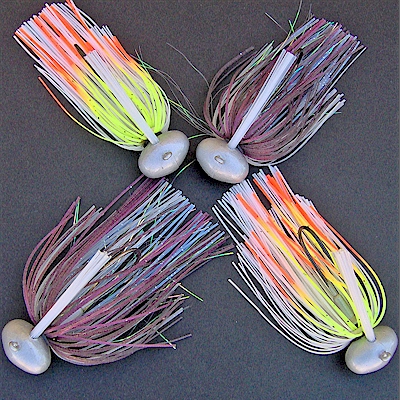
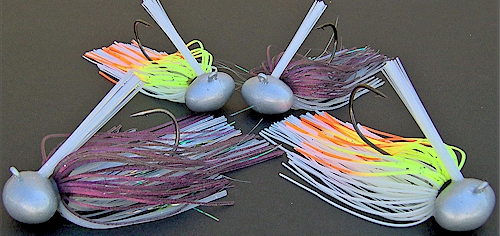
1 oz Swimming Football Jigs. Threadfin Flash and Smallie Special skirts.
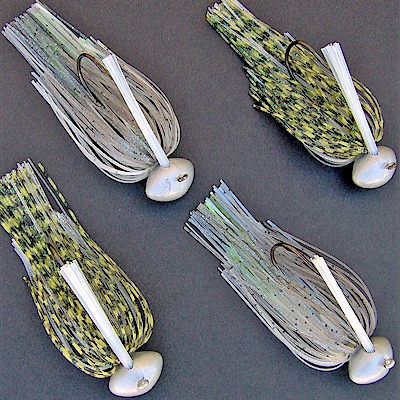
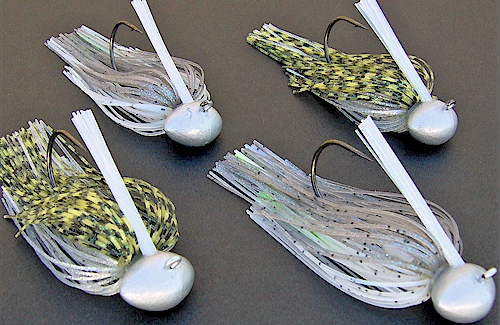
3/4 oz Swimming Football Jigs. Green Shiner and Chartreuse Shad skirts.
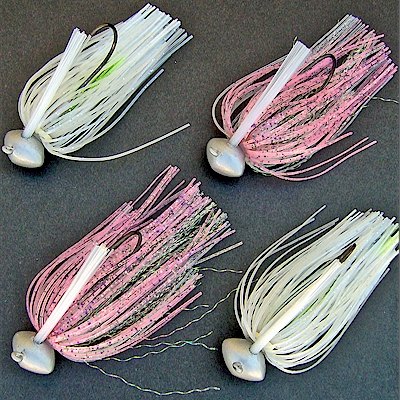
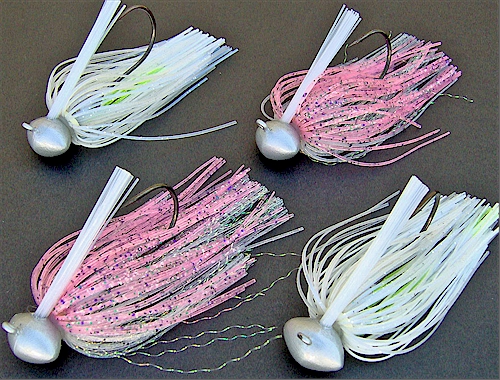
1/2 oz Swimming Football Jigs. Spot Special and Pearl Blue Chartreuse skirts.
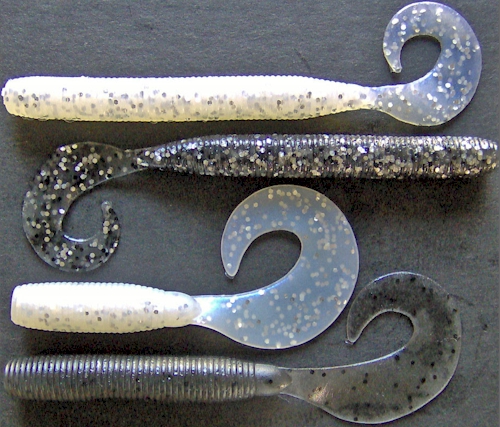
Swimming Football Grubs. Just like a coin has a head and a tail, so too must a jig head always have a tail or trailer. Shown above are Gary Yamamoto Custom Baits 2-series 6" grub tails in color 031 (top); 2-series grub in color 177 (second); 18T-series grub in color 031 (third); and 19T-series grub in color 150.
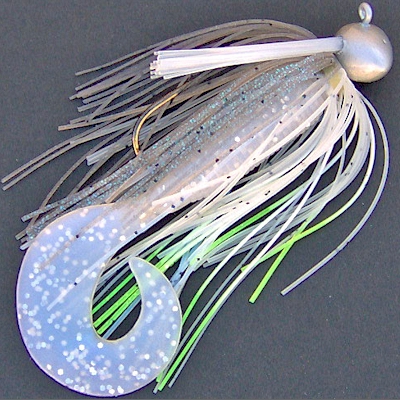
1/2 oz Football Jig ~ Chartreuse Shad ~ 18T-031 Yamamoto Grub Tail
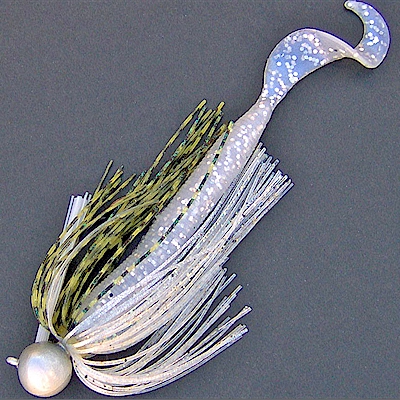
3/4 oz Football Jig ~ Green Shiner ~ 2-031 Yamamoto Grub Tail
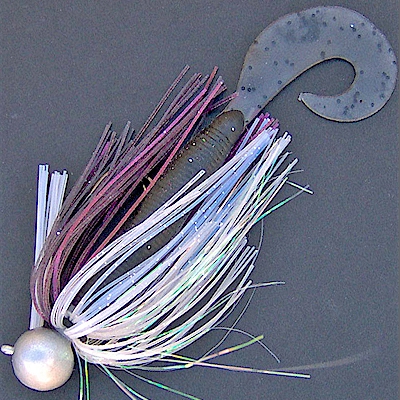
1 oz Football Jig ~ Purple Haze ~ 19T-150 Yamamoto Grub Tail
Swimming a baitfish pattern jig is a different presentation and gets a different reaction from fish compared to slowly bouncing the bottom with a black blue or brown purple or dark color jig. The swimming football jig is a faster, flashier style of jig fishing. Why not give these swimming football jigs a try today? You'll be glad you did.
Tips for the Swimming Football Technique
It is a misconception that football jigs need to be used RIGHT ON THE VERY BOTTOM. I've even come across articles claiming you can't swim football jigs, but that's not true. Yes, these football jigs can be swam in very close proximity to the bottom, but the best approach is so the jigs rarely touch bottom except when YOU momentarily pause of purposely mend slack line to the jig that allows the jig to sink to seek the bottom in order so you may adjust the depth ABOVE BOTTOM at which you are making your swimming presentation. Otherwise, you really don't need to hit bottom at all, except to stop and let the jig touch down every so often to make sure you are near but not on the bottom. This is the case when you are retrieving down a downhill bottom contour. You will occasionally need to pause to let the jig sink to hunker close to the bottom. But once it touches down, start swimming it again.
On an uphill bottom contour, you'll need to do the opposite. Quicken the retrieve until the football jig can no longer be felt bouncing the bottom. One way to help visualize this is to consider the football jig is like a jet plane taking off on a runway. You want the jig to get airborne (start swimming) and you need to accelerate the retrieve enough so that the jig takes off from bottom. Unlike the jet plane however, you want the jig to ideally hover close to bottom - with minimal subsequent touch-offs just to make sure the jig hasn't risen too high. You want to be off bottom but tracking close to it.
What happens when you are swimming along and there's a sudden rise or obstacle such as a bush, a boulder, a ridge shelf jutting up higher than the rest of the terrain is that the swimming football jig will begin to clutch, bounce off and stutter over and through the object. As the football jig bulldozes its way through and past the object, it will start to get that "floating feeling" as it starts to swim smoothly again. That instant when it clears the obstruction as the grabby, snaggy feel turns into a floating swim feel is a high percentage strike point. As the jig bumbles through and pulls clear of whatever's down there, expect it to get belted hard.
Drifting Football Jigs in Current
One other tip, if the water you fish has current or flow, these same football jig excels when cast cross current and allowed to dead drift down current. Actually, cast slightly upcurrent, starting at a 45 degree angle upcurrent (depending on current speed and depth). The current sweeps the jig back down at you. The jig will sink down and start rolling and dragging along bottom if you don't do anything. If you start reeling in just a little line, the jig will perk up and start methodically bouncing bottom instead of rolling or dragging. If you increase the pace to wind in just a little more line, the jig will reluctantly start to "take off" from the "runway" and become temporarily "airborne." Like a plane that may be overloaded too much and cannot make it off the runway - gravity will return the jig to bottom occasionally until it is perpendicular to you (directly in front of you) in the current when water flow pressure neutralizes and overrides gravity's force, your jig should float away from bottom! That is often the moment when the connection is made between fisherman and fish, when the jig is no longer bouncing bottom, but floating freely above it buffeted by the swirling of the current. The jig is fairly neutral for an instant there, like an astronaut in a weightless environment! What happens next instant is the jig switches to being downcurrent from you. Immediately the jig does an about-face 180 turn and starts rising in the current. This sudden rise is a strike trigger. You can't really do it with the rod tip or with reel and line manipulation. It is only the current and the dead drifting tactic that makes these strike trigger moments possible. If there is any fish-holding boulder, hump, wood jam or whatever may hold fish, you really want to orchestrate the instant of the 180 turn-around and rise to happen right there.
So, if you are going to be fishing current a bottom-bouncing approach like this is a good choice for these football jigs for clean (weed-free) sand, shellfish and rock bottoms, channels or whatever (except weedy bottoms). You will need some current flow from mild to strong, which can be matched with the 1/2, 3/4 and 1 oz weights depending on current flow. But keep in mind, you will rarely catch any fish on the bottom-bouncing part when the jig is coming down current. That's only the part used to set up and prepare for the free float when it gets directly in front of you, the turn-around and rise. Nor will you get many strikes once the jig drifts past that point and falls down current from you.
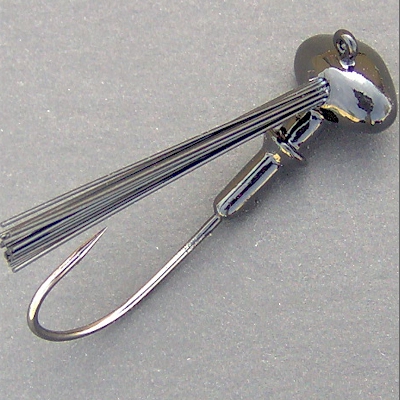
Pro Football Jig Head ~ Black ~ Comes in sizes: (1/4 oz 3/0). (3/8 oz 4/0). (1/2 oz 5/0). (3/4 oz 5/0). (1 oz 5/0).

Pro Football Jig Head ~ Green Pumpkin ~ Comes in sizes: (1/4 oz 3/0). (3/8 oz 4/0). (1/2 oz 5/0). (3/4 oz 5/0). (1 oz 5/0).
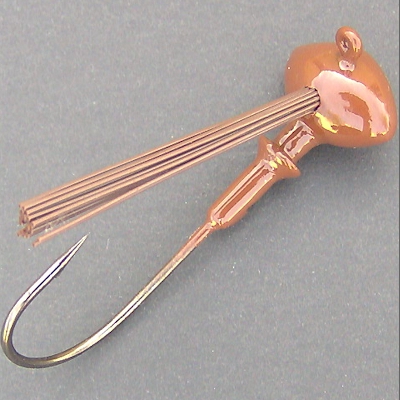
Pro Football Jig Head ~ Brown ~ Comes in sizes: (1/4 oz 3/0). (3/8 oz 4/0). (1/2 oz 5/0). (3/4 oz 5/0). (1 oz 5/0).
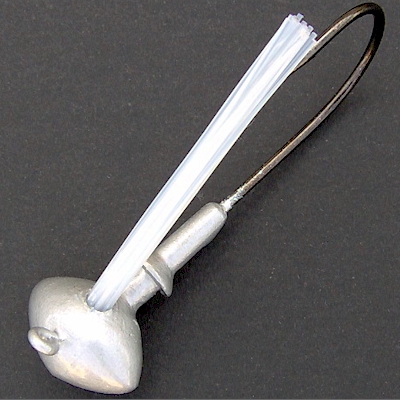
Pro Football Jig Head ~ Silver ~ Comes in sizes: (1/4 oz 3/0). (3/8 oz 4/0). (1/2 oz 5/0). (3/4 oz 5/0). (1 oz 5/0).
For pricing and current availability, please visit http://www.BassdozerStore.com.
Thank you for your business. May your next fishing trip be your best ever!
Regards,
Russ
